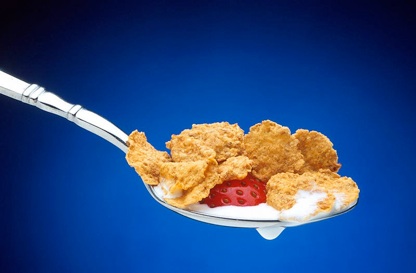Yum. Breakfast is my favourite meal of the day. And hopefully, you should all know by now that skipping it is not a good idea. Breakfast cereals are big business – other than toast, cereals are by far the most common way to start the day. But how nutritious are these cereals? I decided to find out.
I managed to collect nutritional information for 117 of the major branded cereals in the UK. After whacking them into a great big spreadsheet, here’s what I found…
Calories (per 100g)
Mean: 380.56
Standard Deviation: 36.56
In comparison to all of the other categories to follow, calories actually had a pretty low standard deviation. In other words, most cereals provide a fairly consistent amount of energy.
Top 3 (fewest calories)
- Jordan’s Wheat Bran – 188
- Jordan’s Natural Muesli – 325
- Kelloggs All-Bran – 334
Bottom 3 (highest calories)
- Kelloggs Hot Oat Krumbly Original – 482
- Jordan’s Country Crisp Chunky Nuts – 480
- Kelloggs Hot Oat Krumbly Original – 476
The big outlier here was Jordan’s Wheat Bran. Being pretty pure grain, and nothing else, it manages to be the best cereal by an awfully long way for dieters. It’s also pretty amazing for it’s other properties, as we’ll see later. It seems like bran-rich cereals are the way to go if you want to cut down on calorie intake.
At the other end of the scale, it seems not all porridge is created equal. Kelloggs Hot Oats are pretty terrible if you’re looking to shave off the pounds. You could almost have 1.5 times as much of Jordan’s muesli as the Hot Oats and you’d be getting the same calorie intake.
Protein
Mean: 9.3%
Standard Deviation: 2.81
It’s well known among the bodybuilding community that a high protein breakfast is pretty handy for helping to build muscle (but then I guess a high protein anything will help). Protein in the morning is also a good idea to beat hunger. It generally takes longer to burn and it takes less to leave you filling full than carbohydrates. So if a cereal is high in calories, it may not be so bad if it is very high in protein – you might not need as much anyway.
Top 3
- Jordan’s Wheatgerm – 28.4%
- Jordan’s Wheat Bran – 16.3%
- Kelloggs Special K Bliss (Creamy Berry Crunch) – 15%
Bottom 3
- Kelloggs Ricicles, Frosties – 4.5%
- Nestlé Curiously Cinnamon – 4.9%
- Kelloggs Coco Pops – 5%
The Jordan’s ‘raw’ cereals win again. Jordan’s Wheatgerm is more than 25% pure protein! In comparison, a hard-boiled egg has just 12.6% protein. Even Arnie would be proud. Somewhat surprisingly, for me at least, the Special K range is very high in protein as well. Tastes like air, so I have no idea where it comes from. Looks like those adverts with the women in red swimsuits had a shred of truth.
Unsurprisingly, the ‘kiddies’ cereals have the least protein. Our good friends Frosties (probably one of the most popular and heavily advertised cereals) and Ricicles will be popping up later on, and not in a particularly good way.
Sugars
Mean: 22.13%
Standard Deviation: 9.01
Looking at the data, sugar content seems very volatile, with a huge standard deviation. We can pick out most of the healthy and ridiculously unhealthy cereals based solely on sugar content.
Top 3
- Kelloggs Frosties – 50%
- Nestlé Cookie Crisp – 35.8%
- Nestlé Honey Cheerios – 35.1%
Bottom 3
- Nestlé Shredded Wheat – 0.9%
- Jordan’s Porridge, Weetabix Ready Brek, Quaker Oat-So-Simple, Nestlé Shredded Wheat Bitesize – 1%
- Quaker Oats, Paw-ridge – 1.1%
Porridge and Shredded Wheat are in order if you want a low sugar cereal. If you find them too plain, I’m fairly sure you can sweeten it enough without reaching the unhealthy sugar levels of other cereals.
If you are a parent buying your children Frosties, you might like to know that half of the entire cereal is pure sugar. 50%. Yeah. Imagine eating half a slice of toast and having a half-the-size-of-a-slice-of-bread slab of sugar in place of the other half. You might also like to know that a Mars bar – the creme de la creme of over-indulgence – has 59.7% sugar.
Total Fat
Mean: 6.46%
Standard Deviation: 4.76
Fat is even more volatile than sugar. Admittedly, this is down to the fact that some cereals contain nuts and other added protein sources – which pile on the fats but are ultimately healthy.
Top 3
- Jordan’s Country Crisp Chunky Nuts – 22.9%
- Kelloggs Hot Oat Krumbly Original/Fruit – 22%
- Kelloggs Crunchy Nut Clusters Milk Chocolate Curls – 19%
Bottom 3
- Kelloggs Frosties – 0.6%
- Kelloggs Ricicles – 0.8%
- Kelloggs Corn Flakes – 0.9%
As expected, the nuts add most of the fat content to cereals. However, surprisingly, Kelloggs Hot Oats pop up again in a bad way. If you want porridge, there are a whole bunch of better options.
Kelloggs try to make it up by offering the lowest fat cereals around. But that’s because they’re pretty much entirely carbohydrate based. Low fat doesn’t automatically mean healthy.
Saturated Fat
Mean: 1.74%
Standard Deviation: 1.9
Saturated fat content between cereals is more volatile than fat! Really, this is the fat figure that you may want to pay more attention to, since most of the ‘bad’ fats are saturated.
Top 3
- Kelloggs Hot Oat Krumbly Original – 12%
- Kelloggs Hot Oat Krumbly Fruit – 11%
- Jordan’s Country Crisp Chocolate – 6.5%
Bottom 3
- Kelloggs Frosties, Ricicles – 0.1%
- Kelloggs Corn Flakes, Rice Krispies, Honey Monster Sugar Puffs – 0.2%
- Kelloggs Special K Sustain, Just Right, Nestlé Shreddies Honey/Frosted, Golden Nuggets – 0.3%
Bet you wish you didn’t eat those Hot Oats in the morning now, don’t you?
Fibre
Mean: 7.52%
Standard Deviation: 5
Fibre is good for your digestive system. The adverts say ‘it helps keep you regular’. I like the fact that they avoid using ‘poop’ or ‘defaecation’. But I won’t. Fibre helps you poop. There, I said it. Plants (i.e. fruit and vegetables) contain a lot of it. But aside from that, cereals are a fairly major source of fibre for most people. So, aside from eating more fruit and veg, if you have problems in/on the can, you may want to reconsider your cereal.
Top 3
- Jordan’s Wheat Bran – 44.5%
- Kelloggs All-Bran – 27%
- Weetabix Crunchy Bran – 20%
Bottom 3
- Kelloggs Ricicles – 0.8%
- Kelloggs Rice Krispies – 1%
- Kelloggs Frosties, Coco Pops – 2%
So it looks like anything with ‘bran’ in the title does the job for fibre, since bran is, well, fibre, along with the other good stuff that you get from the husk of a grain.
Are you starting to see a pattern at the bottom of the list?
Conclusions
I’m not going to make any recommendations or tell you what to eat – that is entirely up to you – and you are free to use this information to help you in your diet choices. But you can see that a lot of the repeat offenders are sugary kids’ cereals, some of which are not far above chocolate bars and snack foods in nutritional value. Wholegrain cereals (as the adverts tell you) seem to come out on top, with unrefined and unspoilt wheat, bran and oats (porridge) winning most of the nutritional battles.
I didn’t mention sodium content, since all cereals seem to be relatively low in it.
Finally, I’ll leave you with a pretty graph comparing different cereal companies. The raw data is free for you to mull over at your own leisure and is attached below. Bon appetite.



